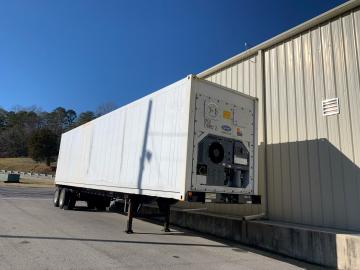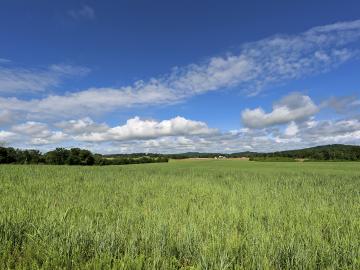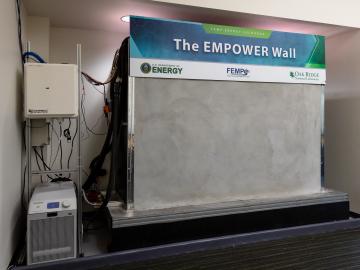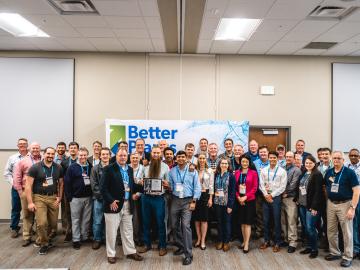
Filter News
Area of Research
- (-) Computational Engineering (3)
- (-) Energy Science (116)
- (-) National Security (30)
- Advanced Manufacturing (8)
- Biology and Environment (59)
- Building Technologies (2)
- Computational Biology (1)
- Computer Science (16)
- Electricity and Smart Grid (1)
- Energy Sciences (1)
- Functional Materials for Energy (1)
- Fusion and Fission (7)
- Fusion Energy (2)
- Isotopes (1)
- Materials (76)
- Materials for Computing (18)
- Mathematics (1)
- Neutron Science (130)
- Nuclear Science and Technology (7)
- Quantum information Science (7)
- Supercomputing (124)
News Topics
- (-) Artificial Intelligence (20)
- (-) Computer Science (43)
- (-) Coronavirus (14)
- (-) Neutron Science (15)
- (-) Polymers (11)
- 3-D Printing/Advanced Manufacturing (81)
- Advanced Reactors (7)
- Big Data (12)
- Bioenergy (28)
- Biology (14)
- Biomedical (8)
- Biotechnology (5)
- Buildings (38)
- Chemical Sciences (14)
- Clean Water (8)
- Composites (17)
- Critical Materials (9)
- Cybersecurity (25)
- Energy Storage (71)
- Environment (59)
- Exascale Computing (2)
- Fossil Energy (2)
- Frontier (2)
- Fusion (2)
- Grid (43)
- High-Performance Computing (11)
- Hydropower (3)
- Isotopes (1)
- Machine Learning (19)
- Materials (36)
- Materials Science (29)
- Mathematics (2)
- Mercury (3)
- Microelectronics (1)
- Microscopy (8)
- Molten Salt (1)
- Nanotechnology (9)
- National Security (37)
- Nuclear Energy (11)
- Partnerships (16)
- Physics (2)
- Quantum Science (3)
- Security (15)
- Simulation (4)
- Space Exploration (3)
- Statistics (1)
- Summit (7)
- Transportation (68)
Media Contacts

Oak Ridge National Laboratory researchers have retrofitted a commercial refrigeration container designed to ensure COVID-19 vaccines remain at ultra-low temperatures during long transport and while locally stored.

Ten scientists from the Department of Energy’s Oak Ridge National Laboratory are among the world’s most highly cited researchers, according to a bibliometric analysis conducted by the scientific publication analytics firm Clarivate.

A team of collaborators from ORNL, Google Inc., Snowflake Inc. and Ververica GmbH has tested a computing concept that could help speed up real-time processing of data that stream on mobile and other electronic devices.

Researchers at ORNL designed a novel polymer to bind and strengthen silica sand for binder jet additive manufacturing, a 3D-printing method used by industries for prototyping and part production.

A team including researchers from the Department of Energy’s Oak Ridge National Laboratory has developed a digital tool to better monitor a condition known as Barrett’s esophagus, which affects more than 3 million people in the United States.

Oak Ridge National Laboratory researchers have developed a novel process to manufacture extreme heat resistant carbon-carbon composites. The performance of these materials will be tested in a U.S. Navy rocket that NASA will launch this fall.

Nearly a billion acres of land in the United States is dedicated to agriculture, producing more than a trillion dollars of food products to feed the country and the world. Those same agricultural processes, however, also produced an estimated 700 million metric tons of carbon dioxide equivalent in 2018, according to the U.S. Department of Agriculture.

Oak Ridge National Laboratory researchers demonstrated that cooling cost savings could be achieved with a 3D printed concrete smart wall following a three-month field test.

As the United States transitions to clean energy, the country has an ambitious goal: cut carbon dioxide emissions in half by the year 2030, if not before. One of the solutions to help meet this challenge is found at ORNL as part of the Better Plants Program.

Researchers at ORNL have developed a robotic disassembly system for spent electric vehicle battery packs to safely and efficiently recycle and reuse critical materials while reducing toxic waste.


